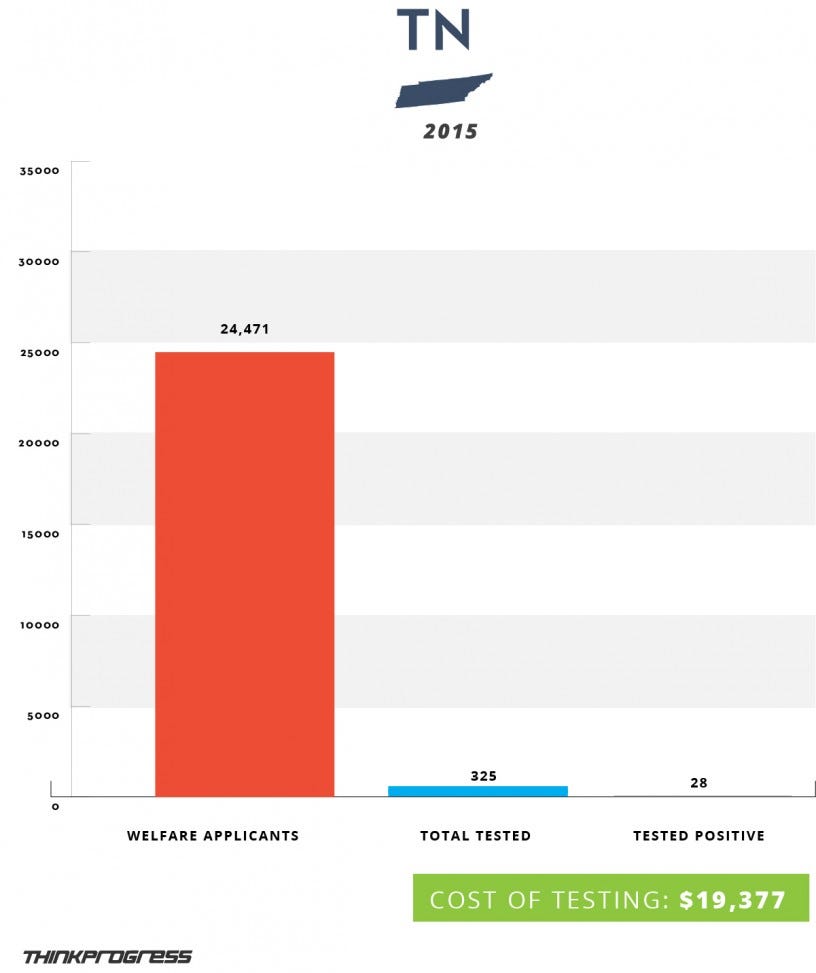NOT.....cost effective. It's just another 'wet dre
Post# of 65629
Read and weep or, better yet, reconsider your opinion on the matter.
Quote:
Drug Testing Welfare Recipients Is A Popular New Policy That Cost States Millions. Here Are The Results.
Go ahead, see if your State is literally pissing away your tax dollars:
https://thinkprogress.org/drug-testing-welfar....n9sucjwtq
By Bryce Covert and Josh Israel

In 10 states, someone who applies for welfare cash assistance through the Temporary Assistance for Needy Families (TANF) program doesn’t just have to deal with complicated paperwork at a time when there’s a good chance she’s already in a state of financial crisis.
She also has to be screened and possibly tested for substance abuse. And if she tests positive, she won’t receive benefits.
Proponents of these programs argue that they’re implemented not just to save money, but to help people who may be struggling with substance abuse. But the data tells a different story.
In 2015, despite lack of evidence that programs in other states accomplished their goals, three more states have implemented similar regimes.
And a ThinkProgress survey of the 10 states that now have these programs in place found that they continue to be expensive and not especially effective. All told, states spent another $850,909.25 on the testing regimes in 2015 to uncover just 321 positive tests — in more than one state, none at all.
This came after a February 2015 ThinkProgress examination of the seven states that had implemented drug testing programs for TANF applicants and/or recipients. At that time, those states had spent about $1 million to create and implement a complicated system of screening and urine testing — and found just 407 drug users.
“If the issue were addressing substance abuse and providing treatment, this is not the approach,” said Liz Schott, senior fellow at the Center on Budget and Policy Priorities. “This is not a policy-based or evidence-based approach or use of resources.”
If lawmakers are truly concerned about substance abuse among welfare recipients, there are more effective options than drug testing. Most states already have requirements for people on TANF to participate in substance abuse treatment programs if that’s identified as a barrier to their employment.
“The sponsors [of drug testing bills] often don’t know what the state actually already does,” Schott said. “If that’s your goal, then why don’t you look at what you’ve got, maybe put some funding into making those programs available, maybe allow participation and treatment to count toward work requirements.”
Clearly some lawmakers are aware that these options exist and choose to ignore them. In North Carolina, which passed its law in 2013, the original bill crossed out the previous provision that required recipients to be screened for drug abuse and referred to a personalized treatment program and replaced it with the blanket TANF drug testing regime. “It was revealing,” Schott said. “It showed the blatant lie to that argument.”
What drug testing requirements do instead is divert already constrained funds. TANF funding hasn’t been increased by the federal government in 20 years, so it’s lost 28 percent of its value. The nearly $2 million states have spent on tests could have instead gone toward assisting people in poverty, including drug treatment programs. “It’s a waste of limited resources,” Schott said. “Resources are going to the administrative process and drug testing companies, and not treatment.”
This evidence may be having an impact on other states, if a slow one. Schott sees the trend toward proposing and passing these bills, which have come at a steady pace of one or two new ones each year for the last five or so, losing steam.
“This year is actually a little slower,” she said. “It may be slowing down.” Even so, lawmakers in West Virginia are currently considering a drug testing bill, while a lawmaker in Congress wants to expand the ability to implement drug testing to food stamps.
 (0)
(0) (0)
(0)